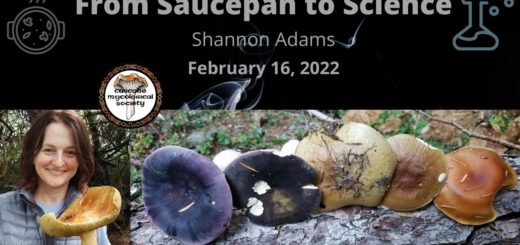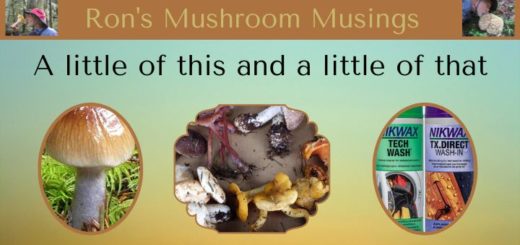My summer vacation

Back in the day before computers, cell phones, the internet and video games dominated our existence, us youngins (a Southern colloquialism for “kids”) actually played outside during the summer. I know it sounds radical now but we really did do things outside and without the accompaniment of a cell phone or iTunes media player. As shocking as that may seem, we simply used our imagination to create all sorts of activities that kept us occupied well into the evening. And, it was important to remember at least some of those summer escapades since the first English class assignment when school started was to write an essay entitled “My Summer Vacation”. I should also mention here that we had to walk several miles just to get to school regardless of snow, rain, heat, or gloom of night. We didn’t mind and it was great physical training for kids who wanted to become one of our essential postal mail carriers after graduation.

While I could go on for several more pages regarding my summer experiences as an adolescent, I do want to stay current since fungi didn’t play much of a role back then. To start, I have to mention the 10 gazillion pound gorilla in the room; Covid-19. This has and is having a significant impact on all of us and greatly influencing much of what and when we do things. That said, Sandy and I love hiking in the woods and not doing so wasn’t an option. We basically focused on hiking during the week, went to less traveled areas, and always had our masks with us just in case. We started our spring hiking in the Metolius area near Sisters Oregon, keeping an eye out for moron morel mushrooms (Morchella species) and the spring bolete (Boletusrex-veris). While we did find a handful of morels, the spring boletes were in much greater abundance and growing in most places we hiked around in. Hiking in the ponderosa pine forests of Eastern Oregon is lots of fun but a day trip from Eugene to Sisters will take about 2h 15min each way. It’s good to get an early start to maximize daylight hunting time and your ability to search around different areas.
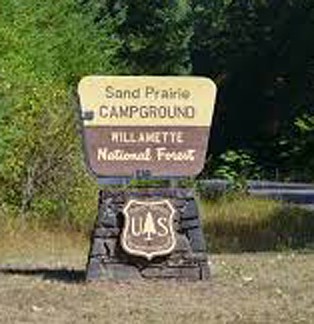
As our excitement for all things bolete started to fade, Marcia Peeters suggested we check out areas off of US Forest Service Rd 21, which can be picked up from Hills Creek Rd just east of Oakridge. Once on US 21 you soon start to drive along Hills Creek lake and through lots of great wooded areas waiting to be explored. We hiked part of the 6.3 mile Larison Creek Trail and will go back to fully hike it once conditions improve. We drove as far as the Sand Prairie Campground, which also has a very nice hiking trail that starts at the back of the campground. Unfortunately, conditions were somewhat dry but some of our more commonly seen Saprotrophic fungi were fruiting while actively doing their invaluable job of decomposing logs and other organic matter.
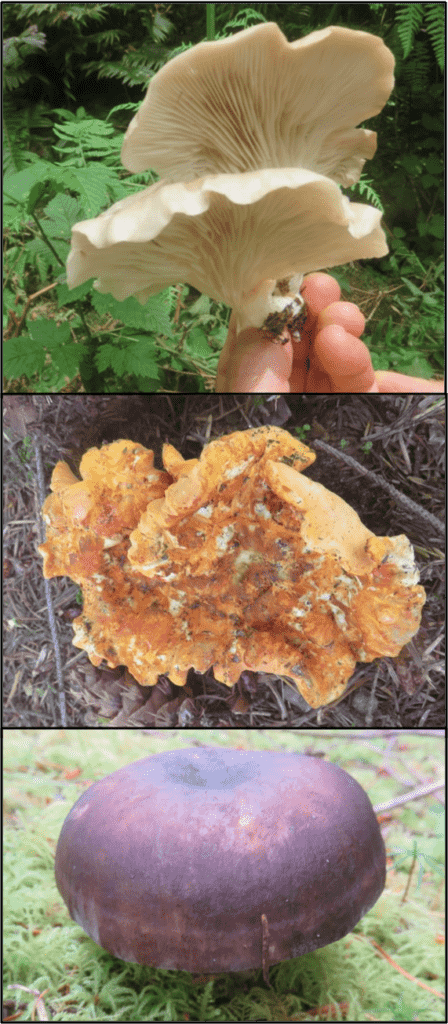
Once the summer kicked into high gear it was time to head for the coast and cooler conditions. When other areas of Oregon are hot and dry, sporadic coastal rain showers and foggy days can create conditions favorable for mushroom fruiting. These dainty little mushrooms are Pleurocybella porrigens or Angel Wings. Edible, well maybe but the general consensus is to avoid them due to suspicious illnesses and deaths recorded in Japan. No worries, there are many other edibles with no dubious circumstances surrounding them. One of these is the Lobster mushroom (Russula brevipes parasitized by Hypomyces lactifluorum). A two in one mushroom that starts fruiting in late summer in low moisture conditions. In fact, you will start to find several mushrooms in the Russula genus starting in late summer and continuing into the fall. One of the more sought after in this genus is Russula xerampelina or the Shrimp Russula. Just make certain of your identification with the shrimper as it can take on several colors and other Russula species can look similar. I apply a few drops of an iron (ferrous) sulfate solution to a piece of the stem which will turn the area dark green if you actually found the Shrimp Russula. Fortunately, no known Russula species in our area is deadly poisonous; but several will make you quite ill.
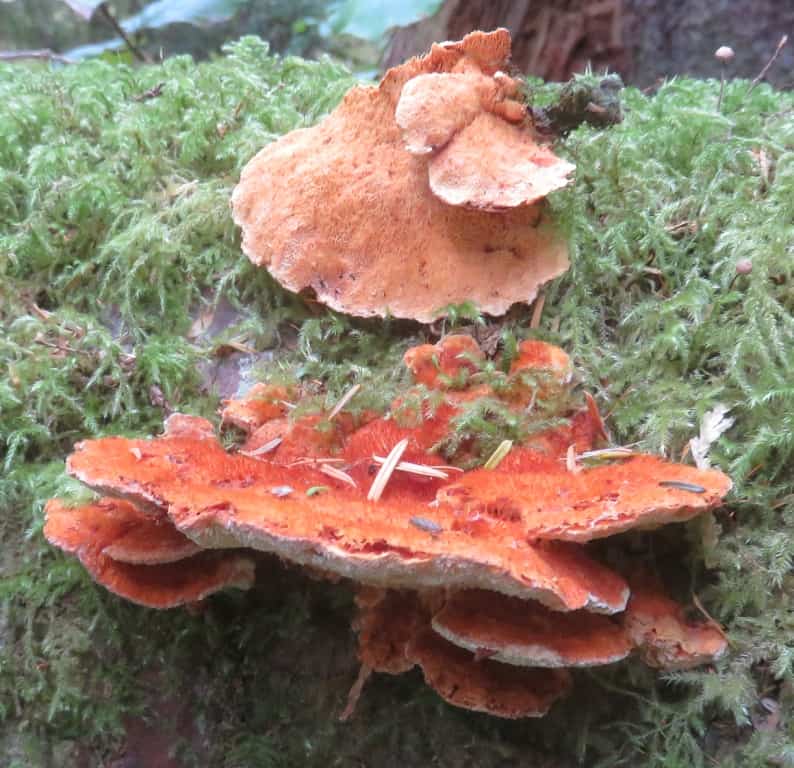
One last mushroom of interest that we found at the coast is in the polypore group. Pycnoporus cinnabarinus is more commonly called the cinnabar polypore. It’s not of any culinary value but its bright orange to red-orange color can mislead those new to mushroom hunting into thinking they may have found the conditionally edible Laetiporus conifericola, which we commonly call chicken of the woods. I temper the edibility of chicken of the woods as it has a very limited time frame where it is both pliable and tender enough to be harvested and cooked. When you apply finger pressure near the edge of this mushroom it should be quite soft and possibly even exude liquid from the pressure. If it is dry or tough leave it alone; you have arrived too late.
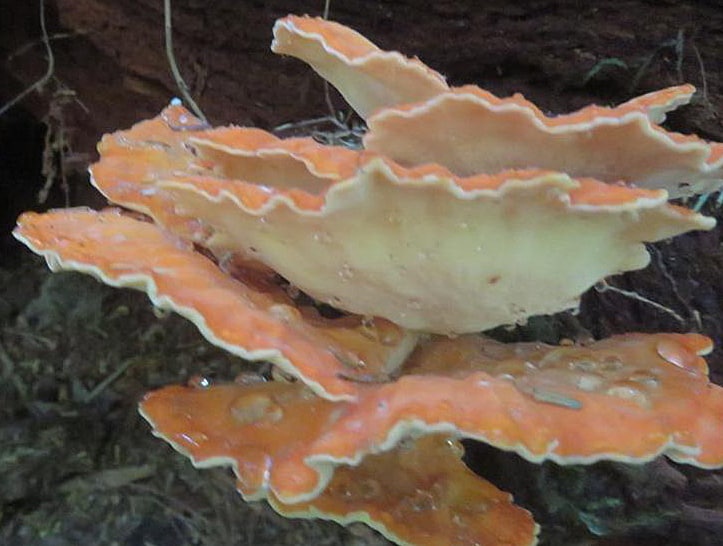
However, since this mushroom can be perennial, mark the spot and time you found it and go back a little earlier next year. Just make certain you have correctly keyed this mushroom out. When fresh, the top surface will be bright orange, the underside bright yellow and covered in tiny pores. If the underside is a dull yellow or white that is also an indicator you’ve arrived too late. Believe me, that has happened to all of us. For your safety, when trying any new mushroom it is strongly recommended that you follow these CMS edibility guidelines.
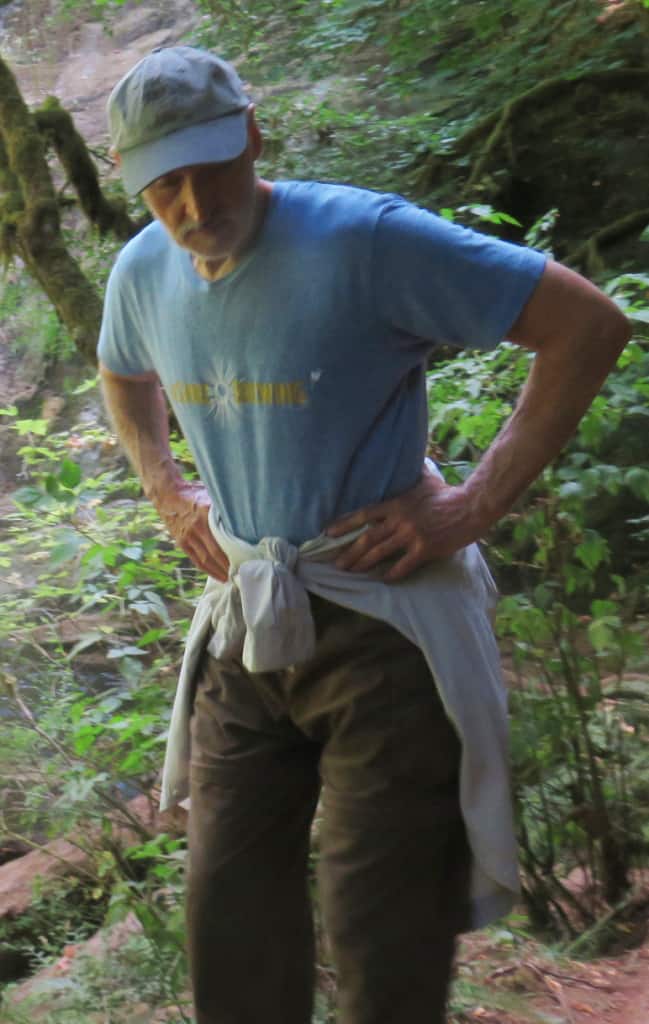
On a final note I’d like to leave you with a warning. During my decade long obsession of hunting for cool mushrooms I’ve noticed a change in my body form. My almost constant leaning downward, scanning the ground for fungal treasures, has lead me to believe I’m regressing to a more primitive form of Homo sapiens. Believe it or not, in this picture I am standing erect or at least my new version of erect. I’ve also noticed I’m doing a lot more grunting and finger pointing rather than coherently speaking. Recently, I’ve acquired quite an affinity for club like shaped pieces of wood. Hopefully, I’m not on the verge of acquiring a full flush of ridged body hair. I am calling this bizarre body-regressive affliction Neanderthal-20. Fortunately, I don’t think it’s an airborne contagion.
Take care and maybe do some vertical body stretching once in a while.
Ron

